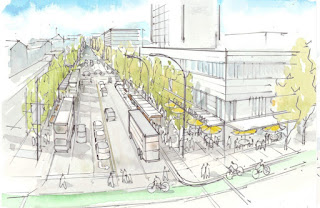The OCP Update: Biases or Constraints
[Back in April, my wife, Irene, wrote this piece about Victoria's Official Community Plan (OCP) update. I thought it was insightful and wise, and she's graciously given me permission to post it here.]
I’ve recently seen a number of people complain that the OCP engagement process is “biased”. But I think that people are confusing biases with constraints. When you go shopping for new appliances, and find out that all models with the features you need cost more than you wanted to pay, do you accuse the store of being biased? Or do you recognize that you are dealing with constraints?This OCP update is responding to a lot of constraints.
The most obvious constraint is new targets for increasing and diversifying our supply of housing.
- The province has ordered Victoria to: Add 4,902 additional homes in the next 4 years; Permit at least 3-4 units on most residential lots, and up to 6 units on some, by June; Complete a standardized 20-year Housing Needs Analysis, and update our OCP and zoning to provide the numbers and types of housing which that analysis projects will be needed.
- Staff’s latest projections say that Victoria will need an additional 34,600 homes by 2050. That’s new homes, in addition to any replacements. This new supply will need to be diverse in both type and tenure to meet the needs of renters, families and households with a range of incomes.
Another big constraint is that Victoria only has a fixed amount of land available.
- Unlike other municipalities, we can’t clearcut nearby forests, or expand onto agricultural land to build more housing. We’ve got to fit the required amount of housing, along with the employment and amenities it will require, onto our existing developable lots, while leaving enough high quality public and private space to foster health and well-being. That means that some development patterns are off the table - they just won’t achieve the goals.
- We aren’t going to bulldoze neighbourhoods or tear through parks to create more road space. We’ve got to support more people, deliveries, etc getting around on the limited rights of way that the city already owns. That means that some transportation patterns are off the table - - basic geometry says they won’t fit.
The final set of constraints is the many strategies and policies that have already been put in place by this or previous Councils.
So this OCP engagement process isn’t intended to be a blank slate where Residents, or even Council and Staff, get to provide open ended opinions on WHAT we think should be done. The housing targets and other constraints already define what goals need to be met. Instead, the OCP engagement is our opportunity for input on HOW we’d like those goals to get met.
That’s not bias, it’s being realistic about the constraints that set boundaries for the OCP. Perhaps the engagement process isn't making that clear enough. Or perhaps some people just don’t want to hear it.
There will be difficult trade-offs for Staff and Council to make as the OCP and Zoning get finalized, and the engagements are focused on getting a broad range of the community’s input about priorities to inform those trade-offs. Although the OCP survey is multiple choice, there are several other ways to provide write-in or verbal feedback, and engage in dialog. You can email ocp@victoria.ca or attend one of the many open houses, info sessions, and pop-up events. I attended the April 6 open house and found staff very receptive to feedback.
But I do think something has been missed. Victoria can’t address our housing targets and the other constraints unless our city changes in some fundamental ways. This OCP and its engagement process is bringing people face to face with that coming change. And change, even change that turns out to be positive, involves feelings of loss and grief, with all the associated cycles of denial, anger, bargaining, and depression before there can be acceptance.



Comments